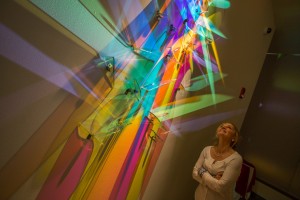- Apply
- Visit
- Request Info
- Give
‘Elemental Light’ Illuminates Eastern’s Art Gallery Until Feb. 23
Written by Michael Rouleau
Published on January 27, 2017

The transformational power of light is on display in the Art Gallery at Eastern Connecticut State University in an exhibition titled “Elemental Light.” Running from Jan. 12 to Feb. 23, the exhibition features the experimental work of Stephen Knapp, who uses dichroic glass to create “light paintings,” and Alex Harding, who makes universe-inspired photographs with vinyl records and television screens.
“Both artists are interested in stripping art down to its most essential component,” said Emily Handlin, Eastern’s gallery coordinator. “Indeed, for both artists, light is the medium and the subject of their work, which encourages us to consider the elemental role light plays in our own perception of the world around us.”

A gallery visitor gazes upward at another light painting.
“I’m trying to take painting in a different direction,” said Knapp at the exhibition’s opening reception on Jan. 19. “For millennia, people have painted to capture light, but I’m using light to paint with.”
Knapp’s light paintings are constructed with pieces of dichroic glass, a dynamic material developed by NASA that transmits, reflects and filters light. The pieces are fastened ambiguously to a wall with stainless-steel brackets. A single 75-watt light bulb brings each piece to life as the dichroic glass casts a rainbow of colors upon the wall like an abstract painting.
“Light is something we are aware of on a subconscious level,” said Knapp, referring to its omnipresence and our tendency to take it for granted. “We sort of let it pass by; I’m trying to remind us of how important light is in our lives.”
Knapp’s seven light paintings play with perspective. “In a dark room, they become more brilliant. You lose track of planes, it goes into different dimensions, into the walls and out from the walls.”
Harding also has a reverence for light, with an acute fascination for that which transmits from the heavens. His series of photographs was inspired by NASA’s Cassini spacecraft, which has taken stunning, up-close photos of Saturn.

Alex Harding explains that he used vinyl records and no digital editing to make these space-inspired photographs
“If Cassini can have one way of looking at the universe, I can have my own,” said Harding. Furthermore, “If Cassini’s photos look otherworldly, why can’t I make my own?”
This idea of “making” photographs, as opposed to “taking” them, speaks to the essence of Harding’s approach. “For me, photography is not about capturing a moment in time. To photograph something new and different, you have to make it, as opposed to go out and find it.
“I started asking, ‘what’s more like Saturn’s rings than an LP?’ So I set up records on a turntable and began photographing under different conditions.”
Using this technique, Harding’s photos resemble a black hole, an eclipse and other celestial images. “There is no digital editing,” he emphasized. “It’s very important to me that everything you see in the picture occurred within the camera.”

This Harding photograph was made with a macro lens one inch from a TV screen, magnified by 500 percent.
This Harding photograph was made with a macro lens one inch from a TV screen, magnified by 500 percent.
Harding has another series on display, inspired by the increase of television viewing he’s experienced while passing the time with his sleeping newborn baby. “How do I make a picture of a television that no one has seen before?” he asked himself.
He decided to invest in a macro lens and take close ups of the TV screen. The result? An inch from the screen and magnified by approximately 500 percent, the photographs depict the red, blue and green of individual pixels.
“These complex, high-definition images are composed of the most basic colors,” said Harding, reflecting on when he stepped back and saw that his camera was photographing a football game. “My photographs show how those TV images are made.”
Coincidentally, at this magnified level, TV screens also have an air of the cosmos; with the pixels surrounded by blackness resembling the starry void of space.
The Art Gallery is located in Room 112 of the Fine Arts Instructional Center on the Eastern campus. Parking is available in Cervantes Garage and in the Student Center parking lot. Gallery hours are Tuesday and Wednesday 11 to 5 p.m., Thursday 1 to 7 p.m., and Saturday and Sunday 2 to 5 p.m. For more information, call the gallery at (860) 465-4659 or visit www.easternct.edu/artgallery/.


